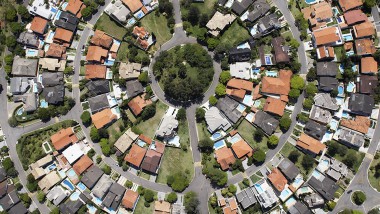Real Estate: Why Diversification Is More Than A Buzzword
Highlights
- Real estate investors are seeking to diversify their assets and future-proof their portfolios. To do that requires geographic and sectoral diversification, a broad mix of asset types and global ESG expertise.
- To increase flexibility, investors are increasingly seeking a single platform, limiting the number of real estate managers they work with.
- Investing alongside a single manager gives investors opportunistic access to deals, as well as the reporting and servicing they need to manage their investments and communicate effectively with clients and regulators.
In the blink of an eye, the pandemic turned these certainties on their head. Value has virtually disappeared from some real estate sectors and has soared in others almost overnight.
The pandemic has upended another certainty: that interest rates and inflation would stay low. In the aftermath of the pandemic, inflation risks have risen and inflation-adjusted returns are a priority for many investors.
Given the emerging risks, real estate investors more than ever are seeking to diversify their assets and future-proof their portfolios. To do that requires geographic and sectoral diversification and a broad mix of asset types from core real estate with safe streams of inflation-adjusted income, to opportunistic assets with potential for sizeable capital appreciation.
Future-proofing real estate portfolios also requires tangible outcomes from ESG-focused activities.
To do all this, investors need flexible managers with deep, global resources and strategies which span the real estate spectrum.
Sectoral Demand Tilts Towards Alternative Real Estate
The standard portfolio model pre-pandemic was a mix of offices, retail and, increasingly, logistics. The office market was remarkably strong, with vacancies at historically low levels.
Despite gloomy predictions, AEW considers that the office market will prove resilient over time and that there is still considerable value in some types of retail too, even if retail space may never recover to pre-pandemic levels.
In retail there has been a negative repricing of values to the extent that some real estate investors believe there is no future for the sector. But the long-term prospects for some assets are still sound. AEW recently bought Windsor Yards, a town centre retail space near Windsor Castle. “It’s an affluent area with huge numbers of tourists yet we were able to purchase it at a 10.5% yield,” says Rob Wilkinson, chief executive of AEW Europe. “You would usually expect to pay 4%-5 % for that kind of asset. We can add further value, such as building more residential real estate there.”
As they reassess where value lies in traditional real estate, investors are also increasingly taking an interest in sectors classed as “alternative”. Alternative real estate includes residential housing, life sciences, data centres, healthcare and student housing. All of these offer the potential to provide inflation-adjusted cashflow streams. Urban consumption logistics is also a growing area, whereby regional logistics hubs are supplemented by local hubs for last-mile delivery.
The shift in direction and momentum has been so strong that competition for some alternative assets has become fierce. Wilkinson says: “We are sensitive to higher prices for alternative real estate assets, but we have been investing in alternative assets for many years, even decades. We see many of these assets as still representing good value and providing many years of rental growth.” In that scenario, even if capital values fall at some point, there is a substantial yield cushion.
Responding to Investors’ Differing ESG Ambitions
ESG is a key component of future-proofing. It’s no exaggeration to say ESG has become a priority for real estate investors.
This preoccupation with ESG is not misplaced: the European real estate industry accounts for around 40% of European energy consumption and around 25% of its greenhouse gas emissions. Governments and regulators are aware of this and are acting. Investors must too.
In addition, green buildings attract more and higher-quality tenants. Not least, a low-energy building is cheaper to run. The cost of reducing energy consumption on a building can be less than 10% of the energy costs saved.
AEW applies innovative sustainability technologies across its real estate portfolio. These include geothermal technologies, cold storage systems, ground-coupled heat exchangers, data management, energy performance contracts, and software applications that measure ESG performance in buildings. It is also introducing climate change stress-testing as a forward-looking measure of sustainable impact.
Real estate investors have varying views on sustainability and what it means to them. “We have the capacity to respond to all levels of ambition for ESG investment,” says Wilkinson. Investor ambitions range from basic information about ESG performance, to detailed scoring, to a full consideration of ESG in the construction and ongoing performance of an asset.
Diversity is another key aspect in defining future value in real estate. “We spend a lot of management time on the E and S of ESG,” says Wilkinson. “It’s critical for clients and for attracting talent. The younger generation is far more discriminating about who they work for and with.”
AEW has refined its governance structures, putting in place a diversity committee to understand how to manage its business going forward.
Staying At Home No Longer An Option
One well-established mechanism for future-proofing real estate is geographic diversification.
Historically, real estate investors have stayed at home. That is, they have largely bought assets in their home market. However, similar to investments in equities and bonds, real estate portfolios are now more likely to include regional, if not global, investment strategies.
“Investors often think they can achieve sufficient diversification with a purely local approach,” says Wilkinson. “The numbers prove that geographic diversification adds considerable value.”
Whereas world stock markets tend to rise and fall in tandem, often to the beat of the US market, there is low correlation between real estate assets in different geographies. “There is almost no correlation, for example, between the value of office space in the City of London and in central Paris,” says Wilkinson.
US investors often wonder why, given the size and variety of their home market, they should allocate to Europe. It is true that over the long term returns in the US market are higher, but so too is volatility. That becomes highly relevant when an investor such as a pension fund or insurer needs liquidity at a time of high volatility.
Some of the largest real estate investors have extensive global programs across the US, Europe, Asia and Latin America. One AEW client, Texas TRS, does exactly that. “They came to us because we have a global platform and can provide access to all asset classes through a range of structures,” says Wilkinson.
Asia is a Key Component of Future-Proofed RE Portfolios
Exposure to Asia is today seen less as a portfolio risk and more as a diversifier and source of attractive returns.
Asian economies are more resilient than in the past and the five-year growth outlook is strong at 3.5% a year on average, with growing investment in infrastructure and strong local consumption boosting growth. Asian real estate markets have deep pools of liquidity, and have been benefiting from easy monetary conditions and a sizeable weight of capital dedicated to the asset class. In addition, as in Western markets, disruption from Covid-19 has created opportunity in logistics, as e-commerce trends have been accelerated.
“We have over 40 employees based in Asia across five offices, and our seasoned APAC senior management have a deep track record in the region,” notes Wilkinson.
AEW APAC has completed $5.6 billion of transactions in Asia since 2014. Recent deals include a mixed-use building in a key central location of Beijing, an office building located in the heart of Melbourne CBD and a high-tech industrial office building in Singapore.
Choosing the Right Level of Risk
After all crises, investors tend to be more risk-averse. Before the pandemic, real estate investors were increasingly concerned about low yields on core real asset assets – assets considered the best quality in the market and therefore less risky. Core assets tend to be in prime capital city locations, have blue-chip tenants with long leases and strong covenants attached to those leases.
The falling yields on these prime assets led a growing number of investors to look at value-add and opportunistic assets. These are assets where the covenants may be less strong, the building may need modernisation or it may be only partially occupied. “We are happy to buy these kinds of assets and use our asset management expertise to reposition them,” says Wilkinson.
Alternatively, in crowded sectors such as logistics, AEW may develop a new logistics hub rather than buying an existing hub. Many real estate managers do not have the knowledge and experience to reposition or develop assets. “With value-add and opportunistic assets, there is less competition and better pricing,” says Wilkinson.
Over the long term, he says, real estate investors on average have allocations of around 80% to core assets, 10% to value-add, and 10% to opportunistic. But many like to have the option to choose and resize their allocations when their needs or markets change. “We have the capacity to offer investors a risk-return level of their choosing, across core, value-add and opportunistic funds and mandates,” Wilkinson adds.
Program Investing and Co-Mingled Funds
Some real estate investors have very precise investment needs or have a strong conviction about a particular market segment. They may, for instance, require program investing, which employs a direct approach implemented through separate accounts and sometimes with operating partners.
The approach may be focused on a particular sector, such as senior or student housing, residential assets or logistics development. Typically, the investor already has considerable real estate exposure and wants to tap specific value streams or filter out certain types of assets. Some of these value streams are changing in the wake of the pandemic, requiring specialist advice and structuring.
The program approach is already popular in France and Germany and the trend is widening to investors elsewhere too.
While program investors often require separate mandates, other investors prefer co-mingled funds where they can access a wide range of assets at smaller ticket prices. This will often be a closed-ended fund, but it could be an open-ended vehicle or a listed investment such as a REIT.
Some investors like to express their convictions through co-investments, which take place alongside deals in closed-ended funds.
“A large global platform such as ours allows for all these structures, and can also enable club deals, where a number of clients on our platform combine to do a deal they otherwise would not be able to participate in,” says Wilkinson.
There is room, too, on the platform for retail investors, who come to AEW principally through banking networks and have access to many of the same strategies as institutions.
The Flexibility of a Single, Global Platform
To access the kind of flexibility that future-proofs a real estate portfolio, investors are increasingly seeking a single platform, preferring to limit the number of real estate managers they work with.
Investing alongside a single manager gives investors opportunistic access to deals, and all the reporting and servicing they need to manage their investments and communicate with clients and regulators.
It also increases flexibility, allowing them to invest in anything from US office space to German retail to match their changing risk-return expectations and their ESG perspectives. “The list of our competitors for doing all this on a global scale is pretty small,” Wilkinson says.
AEW
An affiliate of Natixis Investment Managers
Privately-held French "Société anonyme à conseil d’administration"
Real-estate investment manager under n°T 8324 delivered by the Prefecture de police de Paris
Share capital: €17,025,900
RCS Paris: B 409 039 914
8-12 rue des Pirogues de Bercy 75012 Paris, France
www.aew.com
Natixis Investment Managers
RCS Paris 453 952 681
Share Capital: €237 087 487
43 avenue Pierre Mendès France
75013 Paris
www.im.natixis.com
This communication is for information only and is intended for investment service providers or other Professional Clients. The analyses and opinions referenced herein represent the subjective views of the author as referenced unless stated otherwise and are subject to change. There can be no assurance that developments will transpire as may be forecasted in this material.
Copyright © 2021 Natixis Investment Managers S.A. – All rights reserved





 Next-Generation Real Estate
Next-Generation Real Estate
 Future-Proofing Core Real Estate
Future-Proofing Core Real Estate
 Real Estate Debt Helps Investors Ride out Crisis
Real Estate Debt Helps Investors Ride out Crisis
 Why Has Making an Impact Been Made so Hard?
Why Has Making an Impact Been Made so Hard?